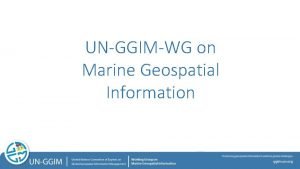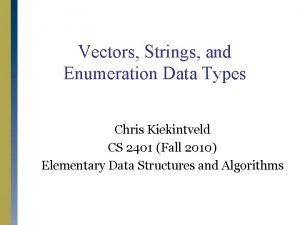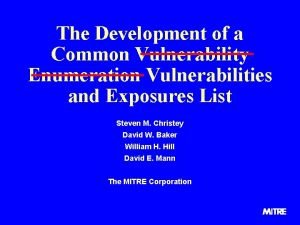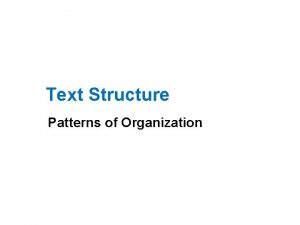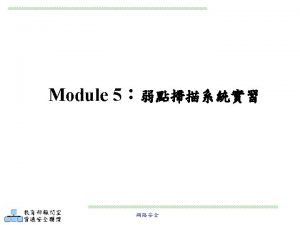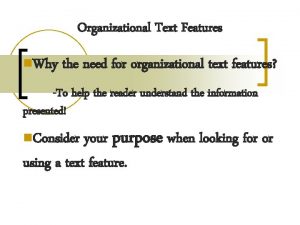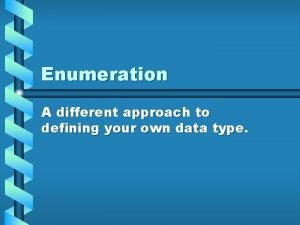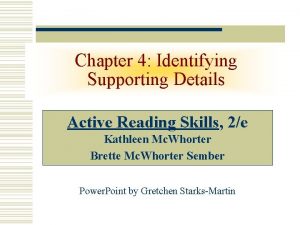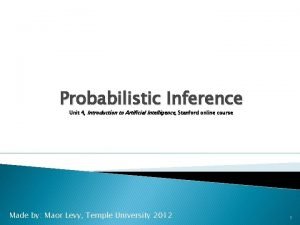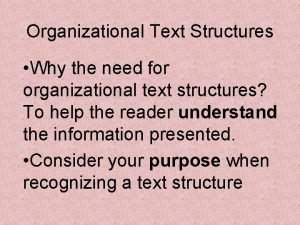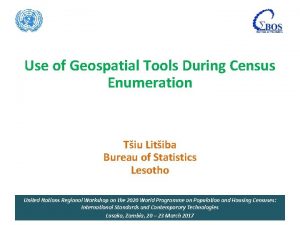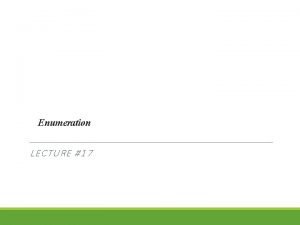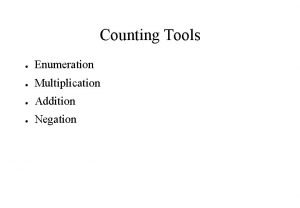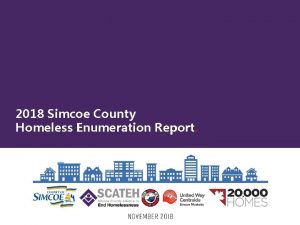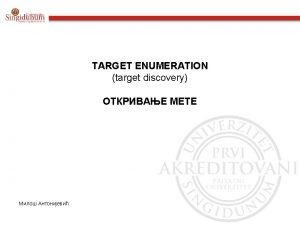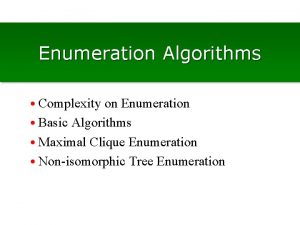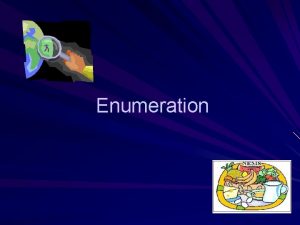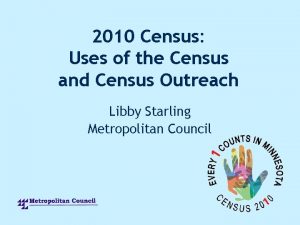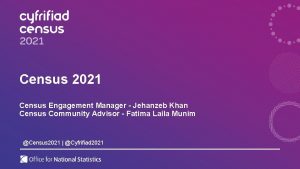Use of Geospatial Tools during Census Enumeration United













- Slides: 13

Use of Geospatial Tools during Census Enumeration United Nations Regional Workshop on the 2020 World Programme on Population and Housing Censuses: International Standards and Contemporary Technologies Lusaka, Zambia, 20 -23 March 2017 Presented by: Ayenika Godheart Mbiydzenyuy UNECA-African Centre for Statistics (ACS) Geoinformation and Sectoral Statistics Section

Introduction The use of geospatial tools as the base for census enumeration where every building is marked by a unique geographic coordinate, is a relatively new concept in Africa as far as census cartography is concerned. The cartographic exercises of previous rounds of censuses in Africa relied much on the traditional census cartographic method. The approach to use geospatial tools by some African countries in the 2010 round, has drastically changed census cartographic methodology in areas including, and not limited to: the use of mobile devices, satellite imagery and Global Positioning System; sampling frames, address register and field verification methods. The presentation aims to raise awareness of the benefits of geospatial tools in dealing with timeliness and data quality issues, which will encourage and provide the basis for policy dialogue on the use of the technology between decision makers, geospatial information specialists, and other stakeholders. Keywords: Census cartography, geo-referenced dwelling frame, Global Positioning System, geographic information systems, enumeration area.

BACKGROUND There a lot of challenges relating to housing census activities in Africa. This section outlines, among others, the most obvious challenges. A) Lack of standard address systems B) Insistent cadastre coverage and referencing system C) Poor data management capacities-data flows, spatial databases development D) Low capacities to utilize appropriate technology E) Poor management of households count F) Difficulty in dealing with scattered settlements

Challenges of the current census methodology in African countries Countries Similarities Differences Traditional census cartography (selected countries and Africa) The Gambia, Mauritania, Namibia, Seychelles and South Africa The Gambia, Namibia, Seychelles and South Africa had EA digital data sets. Mauritania had to develop a new EA digital data set. The Gambia, Namibia, Seychelles and South Africa had to scan georeference and digitalized EAs used in their previous censuses. EA updating methodologies for the Gambia, Namibia, Seychelles, and South Africa consisted of EA boundary modifications and updating using fundamental data sets. The fieldwork exercise for the creation of the geo-referenced dwelling frame, which included verifying or updating EA boundaries and capturing new information, has been completed. Creation of new EAs and capturing dwelling frames in the EAs. Hand designs of EAs were carried out – the delineation of boundaries was difficult as natural and human features were rarely used to carve out EAs. Each census required the complete cartographic exercise of drawing new maps; countries lacked digital data sets that could easily be updated.

Imagery coverage and base map High resolution satellite and photogrammetry imagery were used by the Gambia, Namibia, Seychelles and South Africa (see table 2). Mauritania did not use high resolution satellite imagery in developing the geo-referenced dwelling frame, and as far as the traditional census cartographic method was concerned, no imageries were used – with major landmarks indicated manually on paper maps, which made utilization difficult and led to several errors. Countries Similarities Differences Traditional census cartography (selected countries and Africa) The Gambia, Namibia, Seychelles, and South Africa. High resolution satellite and photogrammetry imagery were used by the Gambia, Namibia, Seychelles and South Africa. Mauritania did not use highresolution satellite and photogrammetr y imagery. No imageries were used – with major landmarks indicated manually on paper maps, which made utilization difficult and led to several errors.

Creation of an accurate geographic frame The Gambia, Mauritania, Namibia, Seychelles and South Africa had similarities in that their enumeration areas represented the smallest building block of the geographic frame (see table 3). The enumeration area boundaries had to be corrected in order to fit the corresponding features on the imagery, and the collected data from the field. Since the current enumeration area and administrative boundaries were derived from old topographic map sheets, the accuracy was not sufficient. Countries Similarities Differences Traditional census cartography (selected countries and Africa) The EAs represented EAs were Field Gambia, the smallest developed in verification, Mauritania, building block of accordance with regard to Namibia, the geographic the different the accuracy of Seychelles frame. administrative the frame, was and South EA boundaries had set-ups in the rarely Africa to be corrected in different conducted as order to fit the countries. That the hand drawn corresponding respected the maps made it features on the census tabulation difficult to verify imagery and the plans developed errors. At collected data by those present, it is from the field. countries. easier to use satellite images and GPS technology to verify the geographic frames created.

Field verification In Mauritania, the necessary selected spatial data layers were transferred to the GPS personal digital assistant (PDA) devices, using the transfer software – manager for Windows mobile devices – which helped to accomplish the field verification and data collection tasks. The methods for estimating the population involved assessing the population of each locality through a complete enumeration of all housing units in the localities. The cartographic agents carried out a house to house evaluation of the population, asking how many people usually resided in the dwelling, and that information was immediately captured into the mobile geographic information system (GIS) environment (see table 4). Countries Similarities Differences Traditional census cartography (selected countries and Africa) The Gambia, Mauritania, Namibia, Seychelles and South Africa All field verifications were conducted using new technologies (GPS) receptors. Mauritania carried out a house to house evaluation of the number inhabitants in order to determine the size of EAs, both in rural and urban areas. Whereas, the Gambia, Namibia, Seychelles and South Africa counted the number of dwellings in order to determine the EAs. Traditional field verification methods involved a house to house evaluation of the number inhabitants in order to determine the size of EAs both in rural and urban areas. Geo-referencing of socioeconomic infrastructure and other landmarks. No geo-referencing of socioeconomic infrastructure and other landmarks. Listing of dwellings and households were conducted during cartographic phase. Listing of dwellings and households were conducted during enumeration phase No development of sketch maps in the field (automatic recording of updates in GPS receptors) Hand development of sketch maps in the field.

Office desktop demarcation, re-demarcation, updating and correction of enumeration area The Gambia, Namibia, Seychelles and South Africa, used imagery to generate dwelling units, through the desktop capture of geo-referenced coordinate points digitized from the satellite images with each point representing a structure or dwelling. Those points, which were given attribute numbers, were overlaid with the satellite images for printing colour maps and for use in the field. Countries Similarities Differences Traditional census cartography (selected countries and Africa) The Gambia, Mauritania, Namibia, Desktop capture of geo-referenced Seychelles and South Africa coordinate points digitized from the satellite images with each point representing a structure or dwelling. Drawings of EAs were done manually and updating or corrections involved constructing new maps entirely. The fieldworkers use the Trimble GPS PDA device to recapture the already identified dwelling units No use of the latest technology in delineating EAs. spatial data bases linked to software, were used to develop digital maps. No data bases were used. Most of the captured information were stored in paper form. Information technology and geographic information staffs worked in the demarcation process. No information technology and geographic information staffs worked in the demarcation process. Updating and corrections were done simultaneously with fieldwork. Updating and corrections were done after fieldwork is completed.

Main enumeration area types Countries Similarities Differenc es The Gambia, Mauritan ia, Namibia, Seychelle s and South Africa The demarcation following EA type and urban EAs, agricultural EAs, rural EAs and vacant EAs VACANT (STATE/PARKS/AGRICULTURAL) =<100 Square km URBAN= 70 Compounds (+-500 people) RURAL= 30 – 50 Compounds (+500 people) EA types failed to follow the tabulation plan Traditional census cartography (selected countries and Africa) Predominantly urban and rural EAs EA types failed to follow the tabulation plan

The desirable features of the Geographic Information System (GIS) mobile devices Key Features of Mobile. GIces It is deemed advisable for mobile GIS devices being environmental friendly, light-weighted, mission specific, easy to learn and easy to configure before usage. Mobile GIS is the combination of geographic information system (GIS) software, global positioning systems (GPS), and mobile computing devices. Mobile GIS fundamentally changes the way information is collected, shared and used in the field. Mobile GIS allows for visualization of information in a digital map interface, this function permits the collection of information at observation points while interacting directly with the world around thereby improving productivity and data accuracy. Mobile GIS increases the accuracy and efficiency of data collection and expands access to spatial data in the field. Collecting spatial data within a GIS environment in the field improves the quality and accuracy of data while administrative and data entry intervals are minimized. Softwares designed to run on mobile computers usually have functionalities for GIS layering, map navigation, querying and hyper linkages. Standard data formats permits the display, query, edit, capture and support for optional GPS receivers functionalities and are capable to be used in desktop computers. Ø Ø Ø Standard Data Formats and Spatial Index of Features Data Projections and Datum Data Display and Data Query Map Navigation Map Querying Map Display Editing and Data Capturing Ø Form Creation Wizard Ø Supporting GPS Receivers 10

Mobile GIS Supports the Following Data Capture Options • These devices support points mode digitalization, positioning averaging when capturing a point feature. Adjustments for vertices in polygons and polylines as well as pause the capturing of GPS lines or polygon features. Data capturing can be suspended and resumes later-on or in the night this maximizes the thresholds of errors. Alarm clocks are part of the device system and can be used to signal and regulate several actions undertaken while using these devicese GIS as a Tool for Supporting Desktops • Soft wares have been customized to support desktops and handheld devices, questionnaire forms can be designed on desktops and transferred into the mobile GIS environment. Equally, map files can be created as well as converted on desktops before loading data into the mobile GIS environment. ationals a Native Languages • Several international and native languages are developed as part of these devices making it possible for massive usage of these devices. mizing the Mobile GIS Framework • In customizing the Mobile GIS Support framework, care is taken for these devices and their softwares to integrate new technologies such as: i) digital cameras; ii) monitoring devices; iii) adds-on hard wares and soft wares etc. Different specific applications have been developed to solve particular problems while using these devices. These applications have been customized to collect data for specific areas such as; crime, hydrology, defends, forestry, mining etc. Hardware System Requirements of Mobile GIS Devices • Mobile GIS devices support traditional hard wares such as desktops, laptops, tablets, cell phones etc. These devices exhibits varieties of deployment options for mobile windows, pocket PCs, chips, palm notes, pen computers etc. The hard ware requirements are 32 or more MB, 133 or more MHZ processors, 10 or more MB free disk for storage, color display, memory card adds-on, extra-maps adds-on etc. GIS Cloud Mobile Data Collection Application • Mobile devices enable the collection of data and conducting of field surveys faster and easier. 11

CONCLUSION The visible benefits have been accomplished through the adoption and sound application of new technologies such as GIS, GPS and high resolution satellite imagery in census mapping and household listings. Although there are several limitations, countries that have used the dwelling frames during the 2010 round have well developed tools and experience essential to improving coverage and quality of fieldwork in the actual enumeration phase of a Census. Invariably, GIS have modified the way in which data from national statistics offices are collected and stored and are produced for census purposes. These countries have integrated GIS into their census mapping processes and household listings in some regard, and most now have developed a solid geo-referenced (GPS) database of dwelling locations, clearly delineated enumeration area boundaries and a complimentary set of high-resolution satellite imagery.

THANKS http: //www. uneca. org/acs/pages/geo-information
 Marine geospatial ecology tools
Marine geospatial ecology tools Marine geospatial ecology tools
Marine geospatial ecology tools Enumeration text type examples
Enumeration text type examples Cve common vulnerability enumeration
Cve common vulnerability enumeration Signal words
Signal words Common vulnerability enumeration
Common vulnerability enumeration What is post enumeration survey
What is post enumeration survey Concept definition text structure
Concept definition text structure What is enumeration text type
What is enumeration text type Spatial occupancy enumeration in cad
Spatial occupancy enumeration in cad Spatial occupancy enumeration
Spatial occupancy enumeration Enumeration transition words
Enumeration transition words Inference by enumeration in artificial intelligence
Inference by enumeration in artificial intelligence Enumeration/listing signal words
Enumeration/listing signal words

